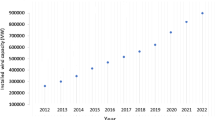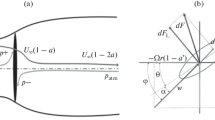Abstract
Wind turbines have been widely used, and one of the main reasons is the low environmental impact caused by these technologies. However, for the Amazon Region the design of small turbines is still challenging, because most of the turbines available present low capacity factor. Hence, this work deals with a new methodology to assess the energy production of a small wind turbine with high capacity factor, specially designed for the Brazilian Amazon Region. The blade element theory was employed into the dynamic equation of the powertrain, in order to establish a steady-state model. Experimental data were obtained using a bench setup developed to test small electric generators. Data for the shaft rotation speed of a synchronous generator with permanent magnets were measured. The interception between mechanical power and generator curves was also proposed to calculate the operating condition of the turbine. All simulations were made in an autonomous system, using a height of 15 m above ground level in the city of Salinópolis on the coastal area of the state of Pará, Brazil. The capacity factor verified was higher than those of two wind turbines of 1 kW available on the market. This result shows that the use of a turbine adapted to low average wind speeds can contribute to a better use of the available wind potential in the region.

















Similar content being viewed by others
References
Akour SN, Al-Heymari M, Ahmed T, Khalil KA (2018) Experimental and theoretical investigation of micro wind turbine for low wind speed regions. Renew Energy 116:215
Grieser B, Sunak Y, Madlener R (2015) Economics of small wind turbines in urban settings: an empirical investigation for Germany. Renew Energy 78:334
Eletrobras-Cepel, Atlas do Potencial Eólico Brasileiro (2016)
Tummala A, Velamati RK, Sinha DK, Indraja V, Krishna VH (2016) A review on small scale wind turbines. Renew Sustain Energy Rev 56:1351
Pagnini LC, Burlando M, Repetto MP (2015) Experimental power curve of small-size wind turbines in turbulent urban environment. Appl Energy 154:112
Wright A, Wood D (2004) The starting and low wind speed behaviour of a small horizontal axis wind turbine. J Wind Eng Ind Aerodyn 92(14):1265
Wood D (2011) Small wind turbines: analysis, design, and application. Springer, London
Vaz JR, Wood DH, Bhattacharjee D, Lins EF (2018) Drivetrain resistance and starting performance of a small wind turbine. Renew Energy 117:509
Azevedo TPSD (2012) Bancada experimental para ensaios em geradores elétricos utilizados em aerogeradores de pequeno porte. Master’s thesis
WEG Industrial Electric Motors—TEFC-W21 high efficiency. http://old.weg.net/ca/Products-Services/Electric-Motors/Industrial-Electric-Motors/TEFC-W21-High-Efficiency. Accessed 07 June 2018
IEEE (1996) IEEE Std 115-1995: IEEE guide: test procedures for synchronous machines part I-acceptance and performance testing part II-test procedures and parameter determination for dynamic analysis. IEEE
Frade LCS, Pinho JT (2002) In: IEEE-PES T&D Latin America
Rohatgi JS, Nelson V, West Texas A (1994) Wind characteristics: an analysis for the generation of wind power. Alternative Energy Institute, West Texas A&M University, Canyon
Mesquita ALA, Mesquita ALA, Palheta FC, Vaz JRP, de Morais MVG, Gonçalves C (2014) A methodology for the transient behavior of horizontal axis hydrokinetic turbines. Energy Convers Manag 87:1261
Njiri JG, Söffker D (2016) State-of-the-art in wind turbine control: trends and challenges. Renew Sustain Energy Rev 60:377
Rueda SAJ, Vaz JRP (2016) Uma abordagem para o comportamento transiente de turbinas eólicas de eixo horizontal (hawt) utilizando a teoria do elemento de pá. Ciênc Eng 24(2):95
Salgado D, Del Castillo J (2014) Analysis of the transmission ratio and efficiency ranges of the four-, five-, and six-link planetary gear trains. Mech Mach Theory 73:218
Glauert H (1983) The elements of aerofoil and airscrew theory. Cambridge University Press, Cambridge
Vaz JR, Wood DH (2016) Aerodynamic optimization of the blades of diffuser-augmented wind turbines. Energy Convers Manag 123:35
Drela M (1989) XFOIL: an analysis and design system for low Reynolds number airfoils. In: Mueller TJ (ed) Low Reynolds number aerodynamics. Springer, Berlin, pp 1–12
Favacho BI, Vaz JRP, Mesquita ALA, Lopes F, Moreira ALS, Soeiro NS, Rocha OFLd (2016) Contribution to the marine propeller hydrodynamic design for small boats in the Amazon region. Acta Amazonica 46(1):37
Benini E (2004) Significance of blade element theory in performance prediction of marine propellers. Ocean Eng 31(8):957
Glauert H (1935) Airplane propellers. In: Durand WF (ed) Aerodynamic theory, vol 4. Springer, New York, p 191
Holanda P, Blanco C, Mesquita A, Brasil Junior A, Figueiredo N, Macedo E, Secretan Y (2017) Assessment of hydrokinetic energy resources downstream of hydropower plants. Renew Energy 101:1203
Selig M, McGranahan B (2004) In: 42nd AIAA aerospace sciences meeting and exhibit, p 1188
Pourrajabian A, Ebrahimi R, Mirzaei M (2014) Applying micro scales of horizontal axis wind turbines for operation in low wind speed regions. Energy Convers Manag 87:119
Singh RK, Ahmed MR (2013) Blade design and performance testing of a small wind turbine rotor for low wind speed applications. Renew Energy 50:812
do Rio DATD, Mesquita ALA, Vaz JRP, Blanco CJC, Pinho JT et al (2014) An extension of the blade element momentum method applied to diffuser augmented wind turbines. Energy Convers Manag 87:1116
Barbosa DL, Vaz JR, Figueiredo SW, Silva MdOE, Lins EF, Mesquita AL (2015) An investigation of a mathematical model for the internal velocity profile of conical diffusers applied to dawts. An Acad Bras Ciênc 87(2):1133
Turbines W (2005) Part 12-1: power performance measurements of electricity producing wind turbines; iec tc/sc 88. Technical report, IEC 61400-12-1
Acknowledgements
The authors would like to thank CNPq, CAPES, GEDAE, INCT-EREEA, PROCAD/CAPES (Agreement: 88881.200549/2018-01), and PROPESP/UFPA for financial support.
Author information
Authors and Affiliations
Corresponding author
Additional information
Technical Editor: Jose A. R. Parise.
Publisher's Note
Springer Nature remains neutral with regard to jurisdictional claims in published maps and institutional affiliations.
Rights and permissions
About this article
Cite this article
Farias, G.M., Galhardo, M.A.B., Vaz, J.R.P. et al. A steady-state based model applied to small wind turbines. J Braz. Soc. Mech. Sci. Eng. 41, 209 (2019). https://doi.org/10.1007/s40430-019-1704-0
Received:
Accepted:
Published:
DOI: https://doi.org/10.1007/s40430-019-1704-0




